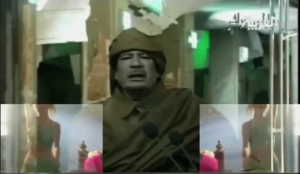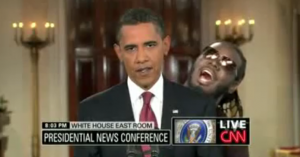
Over a pounding beat and blasting synthesizers, Libyan dictator Muammar Gaddafi pumps his fist in the air, looking as if he belongs in a dance club rather than behind his podium.
As two scantily clad women dance seductively next to him, he emphatically sings the catchy Arabic chorus that would soon catch the world’s attention: “Shebr shebr, beit beit, dar dar, zenga zenga!”
The words mean, roughly, “Inch by inch, home by home, house by house, alley by alley.” In a different context, they would refer to the dictator’s plan to systematically eliminate the Libyan rebels. But in the “Zenga Zenga Song,” Gaddafi’s words inspire an urge to dance instead of an urge to cower in fear.
Gaddafi probably never thought he would become an international pop star. In fact, unless he’s seen the YouTube videos featuring his performance, he probably doesn’t even know it. And he almost certainly doesn’t know that a new breed of video creators just loves making politicians sing, whether they like it or not.
Auto-Tune makes news a hit
In 1997, California music software company Antares released a tool called Auto-Tune, designed to help music producers correct slight imperfections in a singer’s studio recordings.
“When used correctly, you never know it’s being used,” Antares spokesman Marco Alpert says. “That’s the intent— it keeps the inherent timbre of a singer’s voice, preserves all their expressive gestures in the song and just fixes those little problems that might have crept into a performance,” like singing a note slightly flat or sharp.
But Auto-Tune quickly became much more than that. In 1998, Cher used it in her hit single “Believe,” manipulating Auto-Tune’s settings to make her voice sound unnatural and robotic, an effect Alpert calls the “Auto-Tune Vocal Effect.” When rapper T-Pain used it heavily on his 2007 hit album “Epiphany,” the world started to take notice, and artists and fans alike began dividing over whether Auto-Tune enabled a new kind of expression or simply allowed incompetent singers to become pop sensations. Even the New Yorker weighed in on the debate.
“When we design products,” Alpert says, “we try to give enough range to all the various controls to move them well beyond what we think people might want to use them for.” The Auto-Tune Effect—sometimes called the “T-Pain Effect”—was simply one example of that, he says.

In 2008, a New York-based group called the Gregory Brothers started working with Auto-Tune. The group includes Andrew, Michael and Evan Gregory and, despite the name, Evan’s wife Sarah. While playing with the software, they realized it was powerful enough to turn even normal conversations into melodies.
After a few experiments during the presidential elections, the Gregory Brothers launched a video series called “Auto-Tune the News,” a smash-hit YouTube phenomenon that puts music, comedy and news on a collision course. Each video features news clips that the Gregory Brothers edit, modify and assemble into complex, polished pop songs using Auto-Tune. Their slogan? “The only news you need has a bass line.”
Auto-Tuning Congress
One video in the series, for example, starts with Andrew behind a drum set at the head of the U.S. House of Representatives.
“Heyo, Congress!” he yells. “Climate change bill! Let’s get our debate on.”
After he clicks his drumsticks together, Representative Michele Bachmann begins her prepared speech about the bill, just in time to land on the downbeat.
With his floppy hair, fake mustache and, oh yeah, his drums, Gregory does not match the rest of the Congressional décor. Then again, Bachmann doesn’t usually deliver her speeches in polished songs.
“We noticed that news and politics in particular was the area of our society that was the most lacking in bass lines and melody,” jokes Evan, “and we thought that was a gap we could perhaps fill.”
When hunting for clips to include, the group selects “items or issues or statements that are particularly absurd,” Evan says. Once the Gregory Brothers decide what clips to use, they Auto-Tune the people in the clips, splice everything together, and then record their own vocal and instrumental parts to add harmonies and original lyrics. They also film themselves in front of a green screen and add themselves as characters.
The result? Music videos for what amount to original pop songs, with real people and political figures as “unintentional singers” alongside the Gregory Brothers themselves.
Music-Comedy-News
“They’re geniuses,” says Olivia Ma, director of news at YouTube. “They’ve totally created a whole new genre of music-comedy-news that’s pretty incredible.”
Viewers seem to agree—the series’ 23 videos have been watched almost 180 million times altogether, according to YouTube statistics.
The most recent video in the series came out last December. The Brothers say the series is on pause, but that it has allowed them to experiment with new methods of songwriting.
“We see it as a very different approach to songwriting,” Evan says, “taking a kind of archival set of limited material and transforming it into a piece of music in a collaborative format.”
But “Auto-Tune the News” has a political dimension as well.
“What is outrageous portrayal of the news, or outrageous communication of a political idea, often is what makes a good pop song,” Sarah says. One video, for example, plays with a speech in Congress by Indiana Rep. Steve Buyer in which he compares smoking tobacco to smoking a head of lettuce.
“I guess you could say that an effect of us looking for a good pop song also means we’re pointing out the innate drama in today’s media landscape,” she added.
The group denies any partisan bias, noting that its main goal is simply to make something amusing. The series’ most successful video was last year’s “Bed Intruder Song,” in which the Gregory Brothers turned a bizarre man-on-the-street interview about an attempted rape into a pop song. Tasteful or not, the YouTube video has been viewed almost 80 million times, which makes it one of the top 100 YouTube videos ever. The song also cracked the Billboard Top 100 charts.
Other videos in the series, however, engage with serious political issues, delving into seemingly mundane C-SPAN footage of Congressional hearings on tobacco, health care, the federal stimulus and more. Unintentional singers range from President Obama to senators to news anchors, with Katie Couric appearing frequently as one of the group’s favorite characters.
Because of their musical approach, Evan says, their videos may bridge a generation gap “between those who normally watch CNN or C-SPAN” and “a different generation that listens to pop music and hip-hop music.”
The Gregory Brothers are not the first to turn political material into music. In 1984, Jerry Harrison of the Talking Heads, former James Brown bassist Bootsy Collins and producer Daniel Lazarus released a track called “Bonzo Goes to Washington – 5 Minutes,” which sampled an off-color joke made by President Reagan about bombing Russia to create a funky, avant garde song.
“Even within popular music and hip-hop,” says Stanford professor Julie Russo, who teaches a film course on remixes and sampling, “there have often been samples that were used that were not necessarily from other songs but were from other found audio like political speeches or TV shows.”
With Auto-Tune and lots of effort, the Gregory Brothers have been able to do more with the clips they have found. Their videos have much in common with Jon Stewart’s “The Daily Show” or The Onion—both of which the Gregory Brothers cite as influences. But are the stakes higher if every viewer is a potential rebel in a nation on the brink of revolution?
Auto-Tuning a Dictator

Although the world learned about Gaddafi’s obsession with American pop music from a WikiLeaks cable, few suspected he had any musical talent. But when the Israeli DJ and music journalist Noy Alooshe saw one of the leader’s incendiary speeches on TV, he knew that Gaddafi was a natural—even if the speech itself wasn’t actually musical at first.
“The man has his own rhythm,” Alooshe says. “The way he raises his hands is like, you know, he’s in a rave party or something.”
Inspired in part by the Gregory Brothers, Alooshe downloaded the speech online and, using video editing software and Auto-Tune, turned Gaddafi’s words into a catchy melody, one that could accompany the beat of “Hey Baby (Drop It to the Floor),” a 2010 American pop hit by the rapper Pitbull. Then, he added clips of girls dancing to Gaddafi’s rant as an allusion to the dictator’s cadre of female bodyguards.
When Alooshe uploaded the finished video to YouTube in late February, an Internet sensation was born: within just a few weeks, more than 3 million people had witnessed Gaddafi’s musical debut.
In the hands of Alooshe, Gaddafi’s speech about a violent authoritarian counter-revolution turns into a humiliating spoof. Within a week of its release, The New York Times and other media outlets interviewed Alooshe about his creation, spreading the hype worldwide.
Soon enough, Alooshe says, “people from all the Arab countries started mixing it,” creating their own takes on Alooshe’s version and the dictator’s speeches. A YouTube search for “Zenga Zenga” yields more than 5,000 videos, most of which are related in some way to Alooshe’s. One particularly popular spin-off mixes Gaddafi with Shakira’s World Cup song, “Waka Waka (This Time for Africa).” Alooshe himself has since released a follow-up, “Zenga Uooropa,” and has Auto-Tuned other politicians, including Italian Prime Minister Silvio Berlusconi.
As the Arab world faces unprecedented upheaval, with uprisings in Egypt, Tunisia, Libya and elsewhere, Alooshe sees these videos as anything but trivial, despite their comic value.
“This is kind of a weapon,” he says. “You don’t need to go on the street and shout out, ‘Gaddafi die!’ or ‘Gaddafi go!’ You can sit in your home in the dark and make stuff out of him and then upload it to YouTube, and a lot of people will see it and laugh about it.”
Alooshe lives in Israel, not Libya, but through a global platform like YouTube, his work has the potential to affect the way people in other countries think about their own political realities.
Can Auto-Tune lead people to act?
In her 1999 book “Ambiguities of Domination,” Lisa Wedeen argues that humorous political parodies that have much in common with Alooshe’s can indeed be a powerful weapon in oppressive nations like Syria (or Libya), where citizens normally must maintain an outward posture of obedience to the government’s regime for their own safety. When they see a video like “Zenga Zenga” and laugh at it, and then realize that others are laughing too, change may be brewing.
“The point is not that such parodies threaten to generate collective action in the moment,” she wrote, but that they can foster discussions and realizations that you are not alone in the way you feel about the government. These realizations “establish the foundations of what might ultimately eventuate in organized opposition,” she added.
Libyans, however, have not been able to access YouTube easily. According to Google’s online Transparency Report, YouTube has been completely unavailable in Libya since March, which Ma says probably resulted from “some kind of interference” by the government.
But even if few Libyans have seen the video, Ma says “Zenga Zenga” might raise awareness and interest from usually apathetic viewers in other nations, arguing that the humor of a video like Alooshe’s might draw viewers into a serious issue that before they would have ignored.
“It might make somebody who would otherwise just tune out because they think, ‘Libya, that’s halfway around the world, that has nothing to do with me,’ to think about this and then think about Gaddafi as a character in a story that’s happening,” she says. “Then they might actually get interested the next time they see a headline in The New York Times or The Washington Post about this person that they just watched this funny video about.”
Like “Auto-Tune the News,” then, Alooshe’s video and its spin-offs find an audience in a sort of strange middle ground between web surfers on the hunt for new music and those looking for videos about politics.
Geographically, the “Zenga Zenga Song” is most popular in several nations neighboring Libya—Algeria, Sudan and Tunisia—rather than the United States. Although one might expect the video
to be popular among teenagers and young adults, the core demographic for pop music, statistics from YouTube show that it is actually most popular among men aged 45-54, followed by men aged 35-44 and men aged 55-64. The original video has attracted almost 9,000 comments, which of course comprise a mix between offensive or trivial comments and some form of debate.
Russo notes that the video “takes the words of Gaddafi and makes them an anthem about the revolution, in support of the revolution, as opposed to in support of his regime.” Remixes and remix videos, she says, ask us to question the original video’s status as authoritative or “official,” which, in turn, can cause the viewer to rethink Gaddafi’s own power or authority
Even so, she remains skeptical that viral videos like Alooshe’s could create real political change, in part because of the way that YouTube itself functions.
“I think that viral videos on YouTube are not necessarily successful in terms of creating some kind of sustained message,” she says. When a video becomes popular, viewers often spread it through a link with little or no explanation, which “often removes a lot of the context around who made the video, where it comes from, and what that person was trying to do.”
On a broader level, such scholars as Evgeny Morozov in his book, “The Net Delusion,” have cautioned against viewing social media websites like YouTube, Facebook and Twitter as agents of
democracy and liberation, since governments have proven adept at using the sites against the very dissidents and free thinkers who have championed them.
Even so, that hasn’t stopped governments—particularly Arab governments—from feeling threatened by YouTube. In 2007, for example, the Turkish government instituted a national ban on
YouTube after Google refused to remove videos critical of a past Turkish leader from its global servers; the ban lasted for more than two years.
While the “Zenga Zenga Song” and “Auto-Tune the News” videos seem like new, 21st century phenomena, they are closely related to a much older form of political expression. Scott Bukatman, a Stanford art history professor, sees a connection between Auto-Tuned political videos and traditional newspaper political cartoons that date back hundreds of years.
The way in which Alooshe reused and repurposed Gaddafi’s appearance and language, he says, “certainly seems to me an absolutely key way of going about doing a satirical portrait.”
In recent years, Bukatman says, cartoonists have begun to transition from drawing in newspapers to animating online, a medium that comes much closer to Alooshe’s video. The 2010 Pulitzer Prize for editorial cartooning, for example, went to Mark Fiore for his own animated cartoons online. Conceptually, Bukatman says, remix videos like Alooshe’s are a logical next step from newspaper-style political cartoons and animated cartoons.
Bukatman also pointed to an essay from the early 1970s by “Naked Lunch” author William Burroughs entitled “The Electronic Revolution.” Burroughs and some of his friends were experimenting with a new form of creative expression that had a lot in common with the “Zenga Zenga” song.
“The idea,” Bukatman says, “was to take a sheet of paper with writing on it, cut it into quarters, rearrange the pieces, tape it together, and retype and see what you got.” In his essay, Burroughs advocates bringing this technique to sound clips.
“Take a recorded Wallace speech,” Burroughs wrote, “cut in stammering coughs sneezes hiccoughs snarls pain screams fear whimperings apoplectic sputterings slobbering drooling idiot noises sex and animal sound effects and play it back in the streets subway stations parks political rallies.”
Bukatman explains that Burroughs wanted to disrupt the one-way “lines of communication” that the mass media relied on in a pre-Internet era.
In a way, the “Zenga Zenga Song” represents Burroughs’s ideas executed in video form—an official speech modified and combined with other sources to create something new and subversive. As satire, he says, it could undermine Gaddafi’s authority. “How much—who knows?”
The masses can Auto-Tune
Not too long ago, making a video like one of the “Auto-Tune the News” clips or even the less polished “Zenga Zenga Song” would have been extremely difficult, requiring expensive, complex equipment. A fascinating side-story of Auto-Tuned political videos is what they tell us about the availability of the technology involved.
Both Macs and PCs come bundled with free video editing software, Russo says. “Everyone who has a home computer has the ability to make their own movies.”

Even Auto-Tune, formally confined to expensive studios, has become widely available in an iPhone application called “I Am T-Pain,” made by the Palo Alto-based company Smule. For $2.99, users can access an Antares-licensed version of the Auto-Tune software directly from their phones. Over 2 million users have downloaded the application since its September 2009 release.
To promote the app, Smule released a video of a mock interview between President Obama and T-Pain about the healthcare debate. In many ways, it has much in common with “Auto-Tune the News” videos.
Smule co-founder Ge Wang says that the app has allowed people to “Auto-Tune their daily lives,” telling stories about themselves or nights out in song form using Auto-Tune.
“I Am T-Pain” may not be technologically powerful enough to create a video like “Zenga Zenga,” but the app’s mere existence suggests that it’s only a matter of time before everyone has cheap or free software that can do just that. And when it is, how will those videos affect our society?
At the end of “The Electronic Revolution,” Burroughs considers a world in which bizarre, scrambled audio clips are everywhere, “a parody of the President’s speech up and down the balconies, in and out open windows, through walls, over courtyards, taken up by barking dogs, muttering bums, music, traffic down windy streets, across parks and soccer fields.” His vision is of delicious madness, of liberation by destroying the social control that power imposes through organized messages.
But, at the end of the day, perhaps a silly video on YouTube is just a silly video on YouTube. We may laugh, we may even think a little, but we probably won’t revolt when we sign off.
The revolution likely won’t be Auto-Tuned, but the celebration afterward probably will be.
[youtube]0jJkdvI9Etk[/youtube]

Pingback: Website Traffic | The Auto-Tune Revolution — political satire videos fuel political action around the world « Culture & Features « Peninsula Press